Dynamic large-scale network synchronization from perception to action
- PMID: 30320293
- PMCID: PMC6175692
- DOI: 10.1162/netn_a_00039
Dynamic large-scale network synchronization from perception to action
Abstract
Sensory-guided actions entail the processing of sensory information, generation of perceptual decisions, and the generation of appropriate actions. Neuronal activity underlying these processes is distributed into sensory, fronto-parietal, and motor brain areas, respectively. How the neuronal processing is coordinated across these brain areas to support functions from perception to action remains unknown. We investigated whether phase synchronization in large-scale networks coordinate these processes. We recorded human cortical activity with magnetoencephalography (MEG) during a task in which weak somatosensory stimuli remained unperceived or were perceived. We then assessed dynamic evolution of phase synchronization in large-scale networks from source-reconstructed MEG data by using advanced analysis approaches combined with graph theory. Here we show that perceiving and reporting of weak somatosensory stimuli is correlated with sustained strengthening of large-scale synchrony concurrently in delta/theta (3-7 Hz) and gamma (40-60 Hz) frequency bands. In a data-driven network localization, we found this synchronization to dynamically connect the task-relevant, that is, the fronto-parietal, sensory, and motor systems. The strength and temporal pattern of interareal synchronization were also correlated with the response times. These data thus show that key brain areas underlying perception, decision-making, and actions are transiently connected by large-scale dynamic phase synchronization in the delta/theta and gamma bands.
Keywords: Action; Communication; MEG; Perception; Somatosensory; Synchronization.
Conflict of interest statement
Competing Interests: The authors have declared that no competing interests exist.
Figures
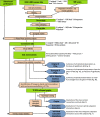
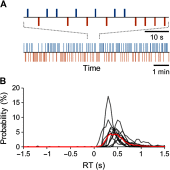


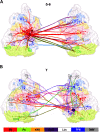
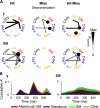
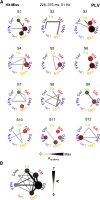
Similar articles
-
Spectral and Anatomical Patterns of Large-Scale Synchronization Predict Human Attentional Capacity.Cereb Cortex. 2020 Sep 3;30(10):5293-5308. doi: 10.1093/cercor/bhaa110. Cereb Cortex. 2020. PMID: 32484218
-
Phase-Amplitude Coupling and Long-Range Phase Synchronization Reveal Frontotemporal Interactions during Visual Working Memory.J Neurosci. 2017 Jan 11;37(2):313-322. doi: 10.1523/JNEUROSCI.2130-16.2016. J Neurosci. 2017. PMID: 28077711 Free PMC article.
-
High-alpha band synchronization across frontal, parietal and visual cortex mediates behavioral and neuronal effects of visuospatial attention.Neuroimage. 2018 Jan 15;165:222-237. doi: 10.1016/j.neuroimage.2017.10.044. Epub 2017 Oct 23. Neuroimage. 2018. PMID: 29074278
-
Functional integration across oscillation frequencies by cross-frequency phase synchronization.Eur J Neurosci. 2018 Oct;48(7):2399-2406. doi: 10.1111/ejn.13767. Epub 2017 Dec 2. Eur J Neurosci. 2018. PMID: 29094462 Review.
-
Different frequencies for different scales of cortical integration: from local gamma to long range alpha/theta synchronization.Int J Psychophysiol. 2000 Dec 1;38(3):301-13. doi: 10.1016/s0167-8760(00)00172-0. Int J Psychophysiol. 2000. PMID: 11102669 Review.
Cited by
-
Distinct Hippocampal Oscillation Dynamics in Trace Eyeblink Conditioning Task for Retrieval and Consolidation of Associations.eNeuro. 2024 Apr 25;11(4):ENEURO.0030-23.2024. doi: 10.1523/ENEURO.0030-23.2024. Print 2024 Apr. eNeuro. 2024. PMID: 38627063 Free PMC article.
-
Linking the microarchitecture of neurotransmitter systems to large-scale MEG resting state networks.iScience. 2024 Oct 9;27(11):111111. doi: 10.1016/j.isci.2024.111111. eCollection 2024 Nov 15. iScience. 2024. PMID: 39524335 Free PMC article.
-
Pre-stimulus alpha oscillation and post-stimulus cortical activity differ in localization between consciously perceived and missed near-threshold somatosensory stimuli.Eur J Neurosci. 2021 Aug;54(4):5518-5530. doi: 10.1111/ejn.15388. Epub 2021 Jul 20. Eur J Neurosci. 2021. PMID: 34251060 Free PMC article.
-
Connectomics of human electrophysiology.Neuroimage. 2022 Feb 15;247:118788. doi: 10.1016/j.neuroimage.2021.118788. Epub 2021 Dec 12. Neuroimage. 2022. PMID: 34906715 Free PMC article.
-
Early brain activity: Translations between bedside and laboratory.Prog Neurobiol. 2022 Jun;213:102268. doi: 10.1016/j.pneurobio.2022.102268. Epub 2022 Mar 29. Prog Neurobiol. 2022. PMID: 35364141 Free PMC article. Review.
References
-
- Blankenburg F., Taskin B., Ruben J., Moosmann M., Ritter P., Curio G., & Villringer A. (2003). Imperceptible stimuli and sensory processing impediment. Science (New York, N.Y.), 299, 1864. - PubMed
-
- Brookes M. J., O’Neill G. C., Hall E. L., Woolrich M. W., Baker A., Palazzo Corner S., Robson S. E., Morris P.G., & Barnes G. R. (2014). Measuring temporal, spectral and spatial changes in electrophysiological brain network connectivity. NeuroImage, 91, 282–299. - PubMed
-
- Bullmore E., & Sporns O. (2009). Complex brain networks: Graph theoretical analysis of structural and functional systems. Nature Reviews Neuroscience, 10, 186–198. - PubMed
LinkOut - more resources
Full Text Sources
